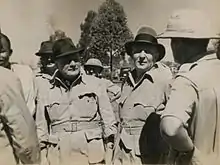Hugh Dow
Sir Hugh Dow GCIE KCSI (8 May 1886 – 20 November 1978) was an Indian civil servant during the British Raj. He served as the Governor of Sindh and was responsible for hanging to death of Pir Pagara Syed Sibghatullah II. The Dow Medical College is named after him.

Career
Dow entered the Indian Civil Service in 1909 and served in various senior administrative and advisory capacities in pre-war India. From 1939 to 1941, he was Director-General of Supply and President of the War Supply Board, India; and from 1941 to 1946, Governor of Sind. He became Governor of Bihar in 1946. He was appointed a CIE in 1932,[1] a CSI in 1937,[2] knighted with the KCSI in 1940 and appointed a GCIE in 1947.[3]
Sindh
Dow served as the second Governor of Sindh from 1 April 1941 to 14 January 1946 succeeding Sir Lancelot Graham.[4] During this period in Sindh he fought the Hur Movement for freedom by declaring a Marshal law. Hur followers of Pir Pagara Jamat were rounded up in 20 detention camps and jailed. He ordered the first areal bombing of Sindh in order to destroy the independent state established by Pir Pagara. Under his governorship on 20 March 1943 Pir Pagara was hanged to death by a British military court. Pir Pagara was secretly buried to some unknown location although Major General Wisal Muhammad Khan who worked as an intelligence officer provides a sketch of his burial place. He laid the foundation stone of Dow Medical College, now a constituent college of the Dow University of Health Sciences, Karachi in December 1945.[5] After Sindh Dow was appointed as the Governor of Bihar in 1946. There he was accused by the Muslim League of letting Hindu mobs kill about 30,000 people in the province.[12] A resolution stated that Hugh Dow, the governor of Bihar and the Indian National Congress were responsible for the massacre. Historians such as Suranjan Das have referred to the Great Calcutta Killings of 1946 as the first explicitly political communal violence in the region.[3]
Later career
After leaving India he was appointed British Consul-General, Jerusalem, and then Chairman of the East Africa Royal Commission.[6]
Personal life
Sir Hugh Dow did brilliantly at school and was awarded scholarships which funded his studies. As he did not come from an elite family, he was sometimes looked down on by those who did. Although his father became a Methodist Christian minister around the age of forty he was not at all interested in any kind of church. He set himself extremely high standards in all aspects of his life and was described as very kind, gentle and generous, but not out-going and rather serious by his granddaughter in a letter to the Dow College.
He had married Annie Sheffield. He and his wife refused to use rickshaws because they thought it was degrading for the men. Instead, they walked and had shelters built for the rickshaw men so that they had a place to sleep and to get out of the rain. Annie was appointed a CBE in 1948 for welfare work.
Annie Sheffield died of cancer in 1956, after that Sir Hugh never married again or had another woman, spending 22 years as a widower in his central London Flat.
They had a son Hugh Peter and a daughter Dorothea Dow, who married an Australian doctor and spent the rest of her life in Wollongong, New South Wales, Australia.
He died in his sleep in November 1978 in London. Dying at 92 years of age, he was still fit and died without a state of illness going ahead. He did daily physical exercises until he was 85 years old.
References
- "No. 33831". The London Gazette (Supplement). 31 May 1932. p. 3573.
- "No. 34396". The London Gazette (Supplement). 11 May 1937. p. 3080.
- "No. 38161". The London Gazette (Supplement). 30 December 1947. p. 7.
- "List of Governors". Sindh Governor House. Retrieved 12 April 2010.
- "Introduction". Dow University of Health Sciences. Archived from the original on 2 April 2014. Retrieved 12 April 2010.
- Dow, Hugh (1976). "A note on the Sindhi alphabet". Asian Affairs. 7 (1): 54–56. doi:10.1080/03068377608729783.
Letter from his granddaughter http://www.thedowdays.com/wp/2017/12/12/the-letter-from-the-grand-daughter-of-sir-hugh-dow/